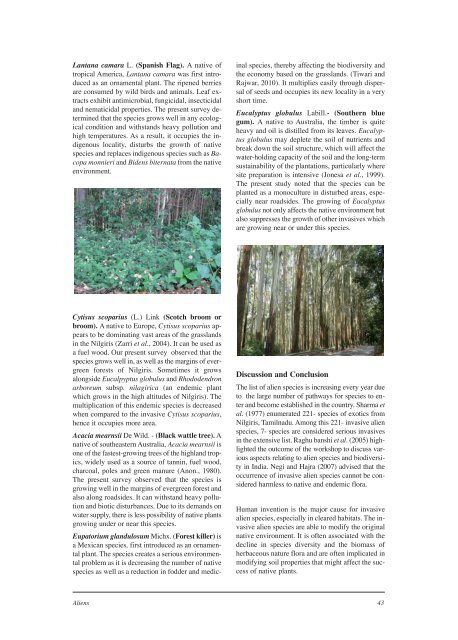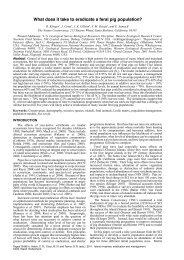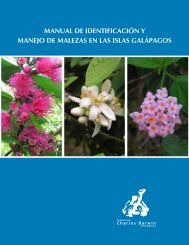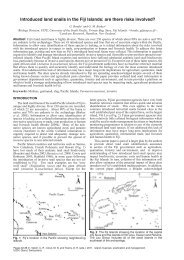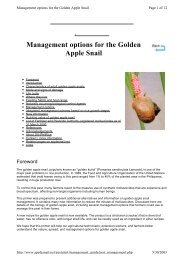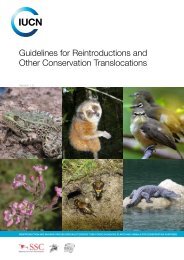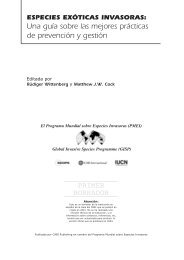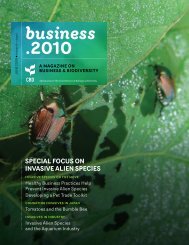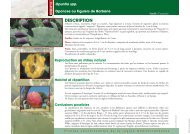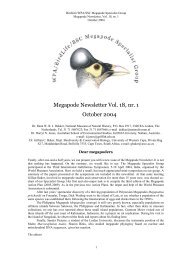Aliens - ISSG
Aliens - ISSG
Aliens - ISSG
You also want an ePaper? Increase the reach of your titles
YUMPU automatically turns print PDFs into web optimized ePapers that Google loves.
Lantana camara L. (Spanish Flag). A native of<br />
tropical America, Lantana camara was first introduced<br />
as an ornamental plant. The ripened berries<br />
are consumed by wild birds and animals. Leaf extracts<br />
exhibit antimicrobial, fungicidal, insecticidal<br />
and nematicidal properties. The present survey determined<br />
that the species grows well in any ecological<br />
condition and withstands heavy pollution and<br />
high temperatures. As a result, it occupies the indigenous<br />
locality, disturbs the growth of native<br />
species and replaces indigenous species such as Bacopa<br />
monnieri and Bidens biternata from the native<br />
environment.<br />
Cytisus scoparius (L.) Link (Scotch broom or<br />
broom). A native to Europe, Cytisus scoparius appears<br />
to be dominating vast areas of the grasslands<br />
in the Nilgiris (Zarri et al., 2004). It can be used as<br />
a fuel wood. Our present survey observed that the<br />
species grows well in, as well as the margins of evergreen<br />
forests of Nilgiris. Sometimes it grows<br />
alongside Eucalpyptus globulus and Rhododendron<br />
arboreum subsp. nilagirica (an endemic plant<br />
which grows in the high altitudes of Nilgiris). The<br />
multiplication of this endemic species is decreased<br />
when compared to the invasive Cytisus scoparius,<br />
hence it occupies more area.<br />
Acacia mearnsii De Wild. - (Black wattle tree). A<br />
native of southeastern Australia, Acacia mearnsii is<br />
one of the fastest-growing trees of the highland tropics,<br />
widely used as a source of tannin, fuel wood,<br />
charcoal, poles and green manure (Anon., 1980).<br />
The present survey observed that the species is<br />
growing well in the margins of evergreen forest and<br />
also along roadsides. It can withstand heavy pollution<br />
and biotic disturbances. Due to its demands on<br />
water supply, there is less possibility of native plants<br />
growing under or near this species.<br />
Eupatorium glandulosum Michx. (Forest killer) is<br />
a Mexican species, first introduced as an ornamental<br />
plant. The species creates a serious environmental<br />
problem as it is decreasing the number of native<br />
species as well as a reduction in fodder and medic-<br />
inal species, thereby affecting the biodiversity and<br />
the economy based on the grasslands. (Tiwari and<br />
Rajwar, 2010). It multiplies easily through dispersal<br />
of seeds and occupies its new locality in a very<br />
short time.<br />
Eucalyptus globulus Labill.- (Southern blue<br />
gum). A native to Australia, the timber is quite<br />
heavy and oil is distilled from its leaves. Eucalyptus<br />
globulus may deplete the soil of nutrients and<br />
break down the soil structure, which will affect the<br />
water-holding capacity of the soil and the long-term<br />
sustainability of the plantations, particularly where<br />
site preparation is intensive (Jonesa et al., 1999).<br />
The present study noted that the species can be<br />
planted as a monoculture in disturbed areas, especially<br />
near roadsides. The growing of Eucalyptus<br />
globulus not only affects the native environment but<br />
also suppresses the growth of other invasives which<br />
are growing near or under this species.<br />
Discussion and Conclusion<br />
The list of alien species is increasing every year due<br />
to the large number of pathways for species to enter<br />
and become established in the country. Sharma et<br />
al. (1977) enumerated 221- species of exotics from<br />
Nilgiris, Tamilnadu. Among this 221- invasive alien<br />
species, 7- species are considered serious invasives<br />
in the extensive list. Raghu banshi et al. (2005) highlighted<br />
the outcome of the workshop to discuss various<br />
aspects relating to alien species and biodiversity<br />
in India. Negi and Hajra (2007) advised that the<br />
occurrence of invasive alien species cannot be considered<br />
harmless to native and endemic flora.<br />
Human invention is the major cause for invasive<br />
alien species, especially in cleared habitats. The invasive<br />
alien species are able to modify the original<br />
native environment. It is often associated with the<br />
decline in species diversity and the biomass of<br />
herbaceous nature flora and are often implicated in<br />
modifying soil properties that might affect the success<br />
of native plants.<br />
<strong>Aliens</strong> 43


